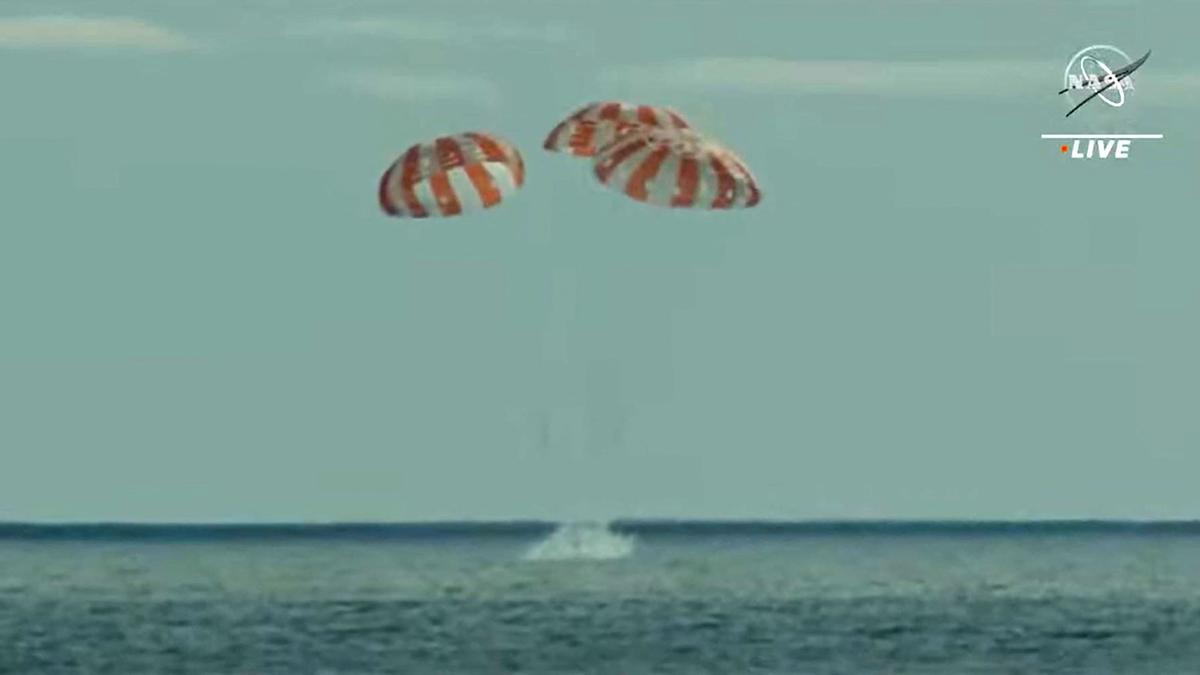The first flight of NASA’s new lunar program returns to Earth after traveling 25 days in space
After more than 25 days traveling through space, flying over the Moon and exploring the path that humanity will one day travel again, Artemis is finally coming home. this sunday has completed successfully the first space mission of NASA’s new lunar program. Around 6:40 p.m. (Spanish peninsular time), the Orion capsule has landed in the Pacific, just off the Mexican island of Guadalupe, to the applause of the mission’s technical team. In this first test flight, the ship was empty. But after the success achieved this Sunday, the next release will go loaded with a new generation of astronauts.
The data on this triumphant return are overwhelming. It is estimated that the capsule has crossed the earth’s atmosphere at about 40,000 km per hour and, at its peak, has come to withstand temperatures of up to 2,800 degrees Celsius. The first images of the capsule show that, despite everything, Orion has successfully survived. Even so, it will have to wait for the results of the more exhaustive analyzes to confirm that the aircraft has withstood these extreme conditions and if, indeed, it is suitable to transport human beings on future missions.
Splashdown.
After traveling 1.4 million miles through space, orbiting the Moon and collecting data that will prepare us to send astronauts into the future #Sagebrush missions, the @NASA_Orion the spaceship is home. pic.twitter.com/ORxCtGa9v7
—NASA (@NASA) December 11, 2022
One of the elements that will be examined more carefully is the spaceship heat shield. It is a security piece built, on the one hand, to prevent the ship from disintegrating during its re-entry into the atmosphere and, on the other, to protect future crew members from the extreme conditions of this moment. The structure, which measures about five meters in diameter, is the largest ever built for a space mission. Future releases of the Artemis program depend, in large part, on this shield working properly. Above all because from the second flight they will incorporate astronauts.
mission ‘splashdown’
After a ‘sprint’ of heart attack, Orion has achieved perch ‘delicately’ on the sea thanks to the help of three huge parachutess that have cushioned the dizzying impact. At the moment of touching the waters, known in English as ‘splashdown’, the mission’s scientific and technical team erupted in enormous applause. Everything has gone according to plan. «The success of this mission opens a new chapter in the history books,» the program’s director of operations enthusiastically exclaimed just after the splashdown this Sunday.
«The success of this mission opens a new chapter in the history books»
Orion perceived in the water for at least two hours to study, among other things, how the ship is cooling down. A team led by the US Navy will then recover the capsule and take it to the laboratory for further study. The mission has collected information about its space journey from about 1,200 sensors, as well as a GPS system and various antennas. All these instruments will allow us to study in detail what Artemis’s first voyage was like and how, based on this, the following ones must be planned.
Fifty years
The artemis success It takes place just fifty years after the last manned mission to the Moon took off. In December 1972, Apollo 17 took off, the last flight of the space program that found that «small step for man and the great step for humanity.» Half a century later, Artemis ushers in a new generation of space missions that in 2025 it will take the first female astronauts to the Moon and that, in turn, will lay the foundations so that one day earthlings can reach the red planet and beyond.
Related news
The roadmap for this new lunar program is clear. Once a mission is successful, it will be displayed a more complex. With new challenges and more and more ambition. If all goes according to plan, in 2024 the launch of Artemis II will pose as the first manned flight test of the Orion spacecraft. The mission will leave Earth, orbit the Moon, and return to its home planet. The flight will last about ten days, will be led by four astronauts and will serve to test the technologies necessary for the long-distance space travel with humans on board.
is 2025 The most important flight of this program will take off: Artemis IIIthe first manned lunar mission of the 21st century. More than fifty years after Neil Armstrong forged the first human footprints in the lunar soil, the Artemis program will achieve the first footsteps of a woman off our planet. It will also be the first time a person of color star in a moonwalk. Until now, the only ones to walk on the Moon have been the twelve men, white and Americans of the Apollo generation.

